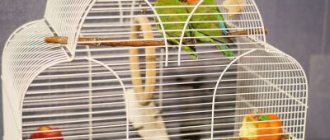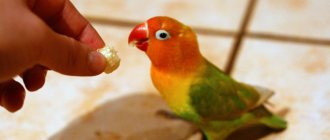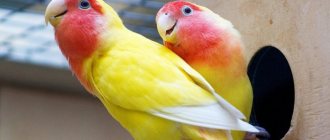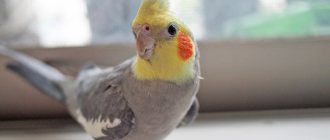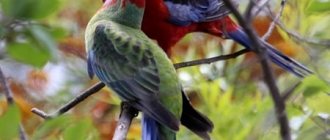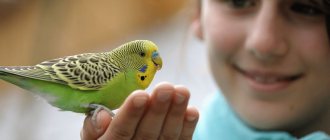People prefer to buy small pets, especially when it comes to living in an apartment. In this case, lovebirds are ideal. The color of lovebirds is quite bright, they easily adapt to living conditions in captivity. There are a number of features that must be taken into account if the bird will live as a pet.
Appearance
What does a lovebird look like? The bird is easily recognized by its small size, squat build, small tail and sharp, rather long beak. A white ring can sometimes be seen around the eyes, which is especially visible against a bright background.
The color of the beak is dark orange, sometimes turning into red. There is a white stripe at the end. The head is painted orange, while closer to the back of the head the color turns into brown. The belly is yellow, the neck and cheeks are slightly darker. All other parts of the body are bright green, with the wings being slightly darker than the body. The tail sometimes has blue spots, but the main color is also green.
In pet stores you can find colorful birds; each of these species was bred through long selection.
Young birds are as similar in color as adults, but their color is slightly darker and grayer than that of adult birds. Lovebird chicks also have black spots under their lower jaws. With age, the color becomes brighter and the dark spot disappears. This is what a lovebird looks like.
Interesting fact. Thanks to the productive work of breeders, it is now possible to purchase a bird of almost any color that a person likes.
Spreading
Lovebirds come from Africa - the southwestern and southeastern parts of it. For some species, the homeland is also the island of Madagascar. The birds live near large bodies of water and usually nest in empty steppes or, conversely, in dense forests in a subtropical climate. Thanks to the large amount of vegetation, birds can easily find food in any conditions.
Who speaks better: female or male
There is no consensus among breeders whether female lovebirds can talk. Observations of poultry show that males learn more easily, but speak words less clearly. They sing a lot and communicate more easily with people. Ten short words or more are memorized and given out. The girls are only seemingly intractable, silent and distant. Stealthily, the females listen carefully to what is said to them. If the female develops speech talent, the breeder can consider this a victory.
A persistent owner can get a lovebird to talk. You just need to understand that this is not speech, but a successful imitation, onomatopoeia. But if a cute parrot does not repeat words, but only chirps, even this will improve the home atmosphere.
If you liked the article or have something to add, then leave your comments and also join our VKontakte group.
Varieties
The most popular species of these birds is not the black-cheeked lovebird, as it might seem, but the pink-cheeked one. Their peculiarity is that they easily adapt to living conditions in captivity and produce offspring without any problems. Diseases of lovebirds are less common in this breed. The main color of the feathers is green, they are found on the back, belly, tail and wings. The head, on the contrary, has a bright red color, gradually changing it as it moves to the body.
Thanks to long breeding work, many birds of other colors were born.
You can also often find Fischer's parrots. They love to talk and easily cope with the “move” to captivity. The body is green, the head is orange, and the chest is yellow. Through selective breeding, you can get a number of very interesting colors from chicks.
An equally popular breed is the masked lovebird. This name was given due to the white “mask” around the eyes.
It contrasts very well with the black head, while the rest of the body is green and the beak is red.
Collared
The body color of these birds is green, the belly and chest are yellow. They have a very beautiful gray-black beak. On the wings you can see stripes of red and black. The name was given due to two stripes - black and yellow, which are found on the neck. The body length is less than 14 cm, the weight rarely exceeds 40 g. They live on average about 10-15 years.
Necklace lovebirds are not often found in captivity, as they are very difficult to catch in their natural habitat. Birds prefer to nest in treetops.
In addition, they are real gourmets who vitally need to eat seeds from their homeland and fresh figs, without which life ends much earlier.
Liliana's lovebirds
This species is very similar to Fischer’s species, but there are a number of differences that immediately show that this is the species in front of a person:
- The body color is light green.
- The second name is strawberry-headed, the name is derived from the color of the head.
- The chest and neck are yellow, and the beak is red.
Females and males are identical to each other. This species is the smallest among the entire breed - the body length does not exceed 13 centimeters, and the weight is usually less than 30 g.
It is very difficult to find in someone’s home, since the birds are close to extinction and their catching is prohibited.
Red faces
The forehead, cheeks and neck of this species are colored orange-red, which is why they got their name. The rest of the body is green. The average weight is around 40 g, the body length is about 15 cm. It is quite easy to find the difference between a male and a female - the former are usually larger, the latter have a more yellowish color.
A distinctive feature is that they love to sleep like bats - upside down. For life, they prefer to choose anthills rather than the tops of tall trees. They dig holes for themselves in advance, usually 40 centimeters deep is enough. For this reason, it is very difficult to tame them in captivity.
But if the owner succeeds, the pet's life expectancy can be 20 years.
Greyheads
Very timid and afraid of everything, birds that are very difficult to catch in the wild. At the same time, it is very difficult for them to get used to life in captivity and are in danger of extinction, which is why they are rarely chosen as a pet.
The second name is Madagascar, after the name of their homeland, they do not differ in size from their red-faced “brothers” - length up to 15 cm and weight up to 40 g. Males and females are easier to distinguish from each other:
- Most of the male's body (head, chest and neck) is gray, the rest of the feathers are green.
- The female has no gray spots.
The wings are the same in color in both sexes - dark green, the beak is not very large and is colored gray.
Blackwing
If you look at the wings of this species, everything will become clear with the name - the bird has black stripes on its wings. The difference between male and female individuals is visible to the naked eye - the former are larger, the color of the forehead is red. The second ones have a green forehead. Mass of birds
Rarely found as pets due to their dull colors. There is also a restriction on catching these birds and subsequent transportation to other countries. Keepers often find it difficult to find a suitable partner, which is why they rarely breed in the wild.
At the same time, this species has a number of advantages relative to others - they are quite smart birds, quite active. Despite all this, they have a calm character. They tolerate life next to birds of other species and other animals in general without any problems.
Black-cheeked
It is very difficult to see in the wild or in captivity, as there are very few representatives of this species left; it is close to extinction. They are even smaller in size than necklace birds. The feathers on the neck are red-red, the crown is dark orange. There is a white “mask” around the eyes, the rest of the body is painted green. Chicks differ from adult birds in the color of their beak - the former have orange, and the latter have red. There are no differences between males and females. Breeders were able to develop several different colors of these birds.
The singing of this lovebird species is the most pleasant of all. They are also not the largest in size: the body length is about 15 cm in length, the weight does not even reach 50 g. Calm birds that do not quarrel with other pets obey and become attached to the owner.
At the same time, they are quite active, they love to fly around the house and explore new territory.
Preparing for training
To begin with, the parrot should be given the opportunity to get comfortable in its new home. It should be taken into account that this pet can only have one beloved owner, and he will be able to train. Other family members should not be involved in this process. When choosing a “teacher”, it is worth considering that high-pitched children’s and women’s voices are easier for birds to imitate.
The parrot will quickly become tame if you follow a few rules at first:
- provide a comfortable cage, feed at the same time;
- do not let him out of the cage until he gets comfortable;
- maintain silence, routine;
- Do not disturb the cage for several days.
It will take your pet 2-3 weeks to master it. After this, you can allow him to explore the apartment. An important part of taming is hand feeding. You can start taking it during the adaptation period. When placing the cage, you need to take into account that the pet must see the owner’s face. A hungry parrot will definitely take food from the palm of your hand. He will quickly understand that nothing threatens him and will get used to feeding from the palm of his hand. If a bird calmly sits on a hand, it trusts its owner, and we can hope for success in training.
Lifestyle
Unlike other breeds, these parrots prefer to gather in flocks consisting of a small number of individuals, which usually immediately form pairs that produce offspring. Sometimes they fight for territory with other flocks. By sunset they usually go to nests, which are located on the tops of trees. In the morning, everyone goes together to look for food. Thanks to their small size, they quickly cover long distances. They feel equally free in flight, when climbing trees and running on the ground.
These are very hardy parrots that often fly great distances while searching for food.
As soon as the time comes to breed, the female herself looks for a place for a future nest. After choosing a pair, from 2 to 10 eggs appear in one tub. The female warms them with her body for about 20 days, after which during the pair the young couple monitors their newly born offspring. The peculiarity of this type of parrot is that the young father, along with his “wife,” takes care of his chicks.
After each child has grown stronger and tested their strength in flight, the young mother prepares for the next birth of her offspring.
Choosing a vocabulary for your pet
Don't set impossible goals. Even with complete trust in the owner and compliance with the rules, the parrot will be able to master only a few words in a year. You can choose them at your own discretion. The main word, of course, is the nickname, which the bird hears regularly. For your pet's vocabulary, you need to choose short, simple options.
Experts recommend giving preference to words with vowels “o” and “a” and consonants “r”, “k”, “ch”, “t”, “p”. There is no need to try to immediately learn phrases with your pet. This will not bring success. You should not move on to the next word if the parrot cannot yet pronounce the previous one well and clearly.
Female and male lovebirds have different learning abilities. Many experts believe that female parrots should not be messed with; they are silent and aloof. Speech talents in females are very rare. In total, a lovebird's vocabulary can contain up to twenty words. If you work with your pet correctly and regularly, you can ensure such a vocabulary.
Diet in the wild
In the wild, birds fly down to look for food. They eat whatever they want. They usually use seeds as food, but do not give up fruits. Among the latter, figs are especially preferred. They can fly many kilometers to search for food and water, especially if there are no more options left in their usual habitat. As soon as farmers begin to harvest their crops, the parrots immediately set out to steal corn and millet.
Parrots are very dependent on water. During extreme heat, they stay close to large bodies of water. They especially prefer those that will quench your thirst for a long time.
Behavior and intelligence
This type of parrot really does not like other birds, constantly showing aggression towards them. The difference in this case is the rosy-cheeked type. They are not afraid of large opponents; they attack birds that are larger than them. They often emerge victorious from these fights. At the same time, they live with their relatives without quarrels, especially in captivity.
They spend daylight hours in constant activity, fly quickly around the house, and are very noisy. This soundtrack bears little resemblance to singing; it can be compared to a kindergarten in which all the children are arguing with each other at the same time. Birds that grow up with people from childhood usually behave quieter than their wild counterparts.
The name of these parrots comes from their affection for each other. But the popular story about the death of the second partner in the event of the death of the first is just a story. The pet will grieve for some time, after which there is a high probability of a new married couple appearing.
Do lovebirds talk? More likely no than yes. If a parrot is constantly trained, it will be able to learn up to a dozen words, but this is not possible with all breeds. The birds are quite smart, calm and active at the same time, and love to explore new territory. The calmest birds are those that have fallen into the hands of good owners since childhood.
Characteristics of lovebirds
These parrots are considered to be quite cunning, agile and calculating birds; they very often require attention to their person and are ready to use different methods for this. These small birds are quite calculating and have enviable ingenuity; to achieve their goal they can use all sorts of tricks, making their keeping very amusing.
To exclude any valuable object from the budgerigar’s field of view, just cover it with something, and the problem is solved. The lovebird, on the contrary, is first of all attracted to everything that is hidden from its eyes; if the bedspread does not give in, the beak will immediately be used.
A reliable lock must be installed on the cage of parrots of this species, otherwise the principle of operation of a simple mechanism will very soon be figured out, and all weak elements will simply be bitten. It is not recommended to leave these hooligans unattended outside the cage, otherwise the matter may turn into general cleaning; in addition, the beak will be applied to everything that catches the eye, so keeping them is not without difficulties.
You can compare the singing of lovebirds with melodic foreign speech; it seems that the birds are constantly chattering in an incomprehensible language instead of their usual singing. Moreover, the nature of the singing always depends on the parrot’s mood; if he is in a good mood, the owner will be able to listen to a poetic narrative with melodic notes.
If the bird is upset, its singing will begin to resemble swearing with croaking and creaking sounds, which means it requires care and attention. Keeping these parrots should provide them with constant attention from them.
